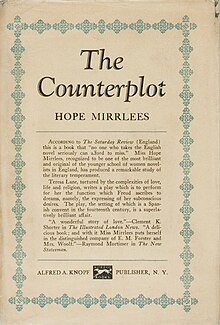The Counterplot
 First US edition cover | |
| Author | Hope Mirrlees |
|---|---|
| Country | United Kingdom |
| Language | English |
| Genre | Novel |
| Publisher | Collins (UK) |
Publication date | 1924 |
| Media type | Print (Hardback & Paperback) |
The Counterplot is the second novel by Hope Mirrlees. Written in 1923, it was originally published in 1924, and is the only one of Mirrlees's three novels to take place in then contemporary settings, Madeleine: One of Love's Jansenists (1919) being a historical novel, while Lud-in-the-Mist (1926) is a fantasy.
Hope Mirrlees dedicated The Counterplot to Jane Harrison, with an epigram taken from Odysseus' address to Nausicaä in The Odyssey.[citation needed]
Synopsis[]
The novel's protagonist is Teresa Lane, a woman of 28, living in Plasencia, a villa in the South-East of England, shortly after World War I, who studies the spectacle of her family life with the intent of transforming it into art. The result is a play, The Key, written by Teresa after the style of the Spanish autos sacramentales and set in Seville during the reign of Pedro the Cruel, the text of which is reproduced in its entirety within chapter eleven.
A list of books by the same publisher, appended at the end of the novel, includes a brief description of The Counterplot, calling it "a study of the literary temperament".[1]
Reception[]
The Observer wrote that "Miss Mirrlees' style is compact, forcible, and sometimes rarely beautiful."[2] Meanwhile, The Guardian noted the novel's complexity, noting that "is not easy to read, but the reward of it is worth the effort."[3] In a brief review of the work, The Nation compared Mirrlees' writing style for this novel to Walter Pater as well as Thomas Browne and Joris-Karl Huysmans.[4]
Influence and legacy[]
A French translation appeared in 1929 under the title Le choc en retour, tr. Simone Martin-Chauffier, published by Plon, Paris.[citation needed]
In a diary entry dated 24 March 1955, writer Christopher Isherwood wrote that The Counterplot has "been one of the truly 'formative' books in my life", further writing that he knew "whole passages of it nearly by heart."[5]
References[]
- ^ Connor, John T. (10 April 2014). "Hope Mirrlees and the Archive of Modernism". Journal of Modern Literature. 37 (2): 180. doi:10.2979/jmodelite.37.2.177. ISSN 1529-1464. S2CID 154682710. Retrieved 22 February 2021.
- ^ "Miss Mirrlees's New Novel". The Observer. 17 February 1924. Retrieved 20 February 2021.
- ^ "The Counterplot Review". The Guardian. 29 February 1924. p. 7. Retrieved 20 February 2021.
- ^ "Books in Brief". The Nation. 121 (3139): 261. September 2, 1925. Retrieved February 24, 2021.
Miss Mirrlees, who is as urbane as Sir Thomas Browne or Huysmans, writes as beautifully as Pater; and the rarefied world that she weaves like a canopy over the discordant, unrelated, irrelevant lives below has the imperishable fragrance of Pater's prose.
- ^ McMillan, Dorothy (10 December 2019). ""From Scotland to the World": The Poetry of Hope Mirrlees, Helen Adam, Muriel Spark, and Veronica Forrest-Thomson". Humanities. University of Glasgow“From Scotland to the World”: The Poetry of Hope Mirrlees, Helen Adam, Muriel Spark, and Veronica Forrest-Thomson. 8 (4): 184. doi:10.3390/h8040184.
External Links[]
- 1924 British novels
- Alfred A. Knopf books
- William Collins, Sons books